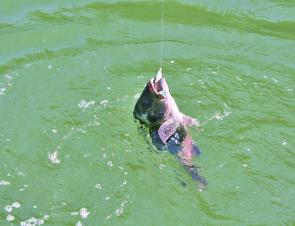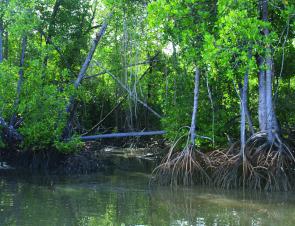Hard to believe, but with the water temperature sitting on 28ºC the barra were shut down. Poor blighters get cold if the water does not resemble a warm spa. Flicking lures into the snags soon revealed more red flashes than silver, so we started down-sizing the barra lures to something more suitable to mangrove jacks.
After a reasonably good day in the snags, I had worked out one interesting fact. Unlike most snag dwelling species, the mangrove jacks that we had landed were all well in the snags and not one dared venture out to hit a lure. Even little archerfish were game to leave the snag to chase a lure and pikey bream would chase them all the way to the boat, but not the jacks.
Whether it was the time of year, location, or just the fact that the sun was high or the fish were all very well fed, it meant that if they weren’t interested in coming to me, I was going to have to go to them.
Returning home, I gave this fact a lot of thought and with a mate coming up from Brisbane to do some fishing, I got on the phone and asked if he could bring with him some ultra light jigheads with 2/0 hooks in them. I was thinking that if I can drop a prawn or shad shaped plastic into the snag and allow it to slowly drop through the sticks, it should get eaten.
True to his word, my mate Luke arrived at Weipa airport with a rod tube and a box of light jigheads, ranging from 1/32oz to 1/8oz. I think that he may have had a couple of other things as well, like wife and children, but I can’t be sure ‑ Being handed 50 packets of jigheads can distract a man’s attention, especially in Weipa where tackle junkies are forced to go cold turkey.
Heading up one of my favourite jack creeks, I was keen to see if the light jigheads would do the trick. There are two big rock bars in the creek worth flicking a lure at before you arrive at the snags so we were soon into our first jack of the day from the stones. But I was itching to get into the snags.
The technique was simple: Rig a Berkley Gulp shrimp onto a 1/16oz jighead and skip it into the snags. Skipping plastic prawns is a trick I had learnt from my bream fishing days on the Gold Coast. On threadline tackle I was able to either use a ‘bow and arrow’ style cast or just a solid cast low to the water that would see the prawn skip two or three times before resting in the snag.
The little prawn skipping on the surface of the water resembles one fleeing from predators and can really fire up fish like mangrove jacks that love to devour a frightened prawn. Cast the lures hard and low to the water to get them working as you would if you were skimming flat stones along a smooth lake.
Keep the jighead as light as possible and use the lightest braid that you can get away with. I use 12lb braid with a 20lb leader and landed 90% of the jacks that we hooked. I just hit them as soon as I felt a bite and went hard until they are out of the snags.
Once the cast had been made, I just let the lure slowly sink into the timber. If the snag was shallow, I would let it sink until I thought I would get hung-up and then rip it out. Deeper snags allowed me more time to sink the lure but it was vital to the techniques success to keep the lure slowly sinking for as long as possible. I spent the day fishing with 1/16oz jighead because the breeze was putting a bow in the line that needed just a little bit of weight to stop the wind from pulling the plastic out of the snag but when there is no wind, I would be looking to go lighter to allow for an even slower sink.
Because the fish were not coming out of the snags after the lure had dropped into the structure, it was ripped out and skipped into the next snag. No retrieving, flicking, twitching or dancing at all. The action of the lure was done on the cast into the snag and that is what was getting the attention of the mangrove jacks. It is a soft plastic retrieve in reverse.
Most other retrieves have the lure doing the work after it is tossed out to the fish but this one requires all the action to be done during the cast, and if no takers, pick another snag. If you have time to twitch it in the snag, then you are not letting it sink for long enough. It is that simple, once you get the cast right.
On subsequent trips, I have used small shads and grubs instead of shrimps and, while my preferred lure for this technique is still the 3”Gulp Shrimp, any lure that can be skipped into the snag will work. Jigheads with a 2/0 hook, such as Nitro’s and TT’s, are strong enough but if you are using other brands or smaller hooks, make sure that they will stand up to the line class because you will be smoked if you go soft on a mangrove jack in the snags.
We have been catching double figures of jacks every trip and only go through a few jig heads so spend the money on the better quality heads.
The best thing about living in Queensland is that there are mangrove jack fisheries all along the coast and while the quantity may dwindle down south, the quality certainly makes up for it. Just remember, get right into the fish’s lair and they’ll bite at any time of the day. If you miss by a foot, you’ll come up well short.
Reads: 3739
The best thing about living in Queensland is that there are mangrove jack fisheries all along the coast.

I have used small shads and grubs instead of shrimps and, while my preferred lure for this technique is still the 3” Gulp Shrimp, any lure that can be skipped into the snag will work.

Unlike most snag dwelling species, the mangrove jacks that we had landed were all well in the snags and not one dared venture out to hit a lure.




